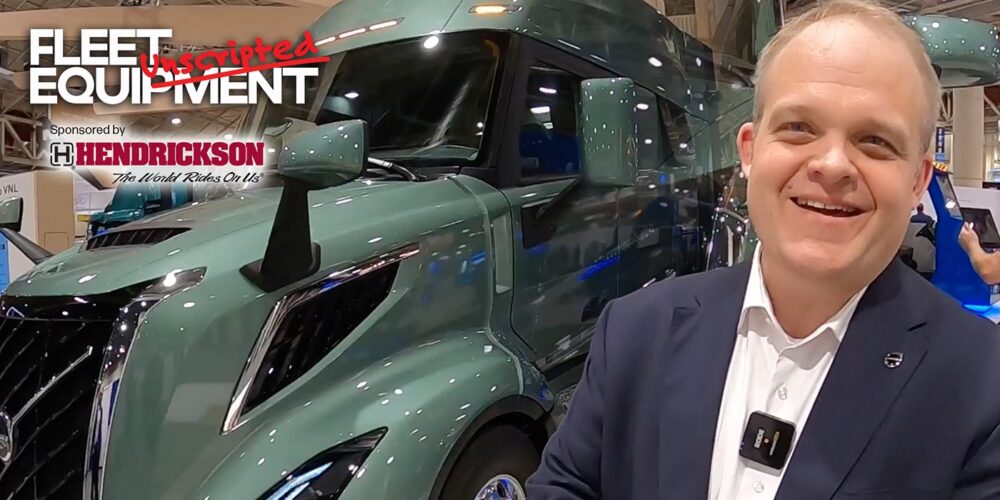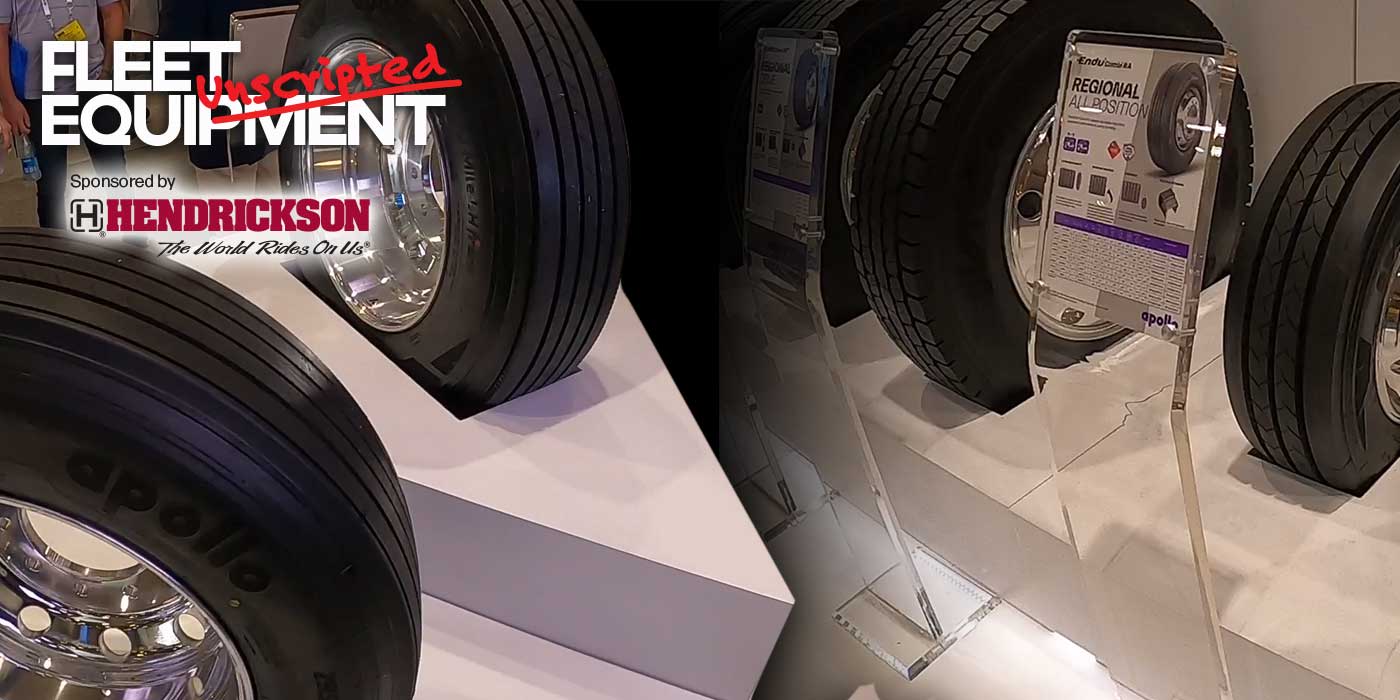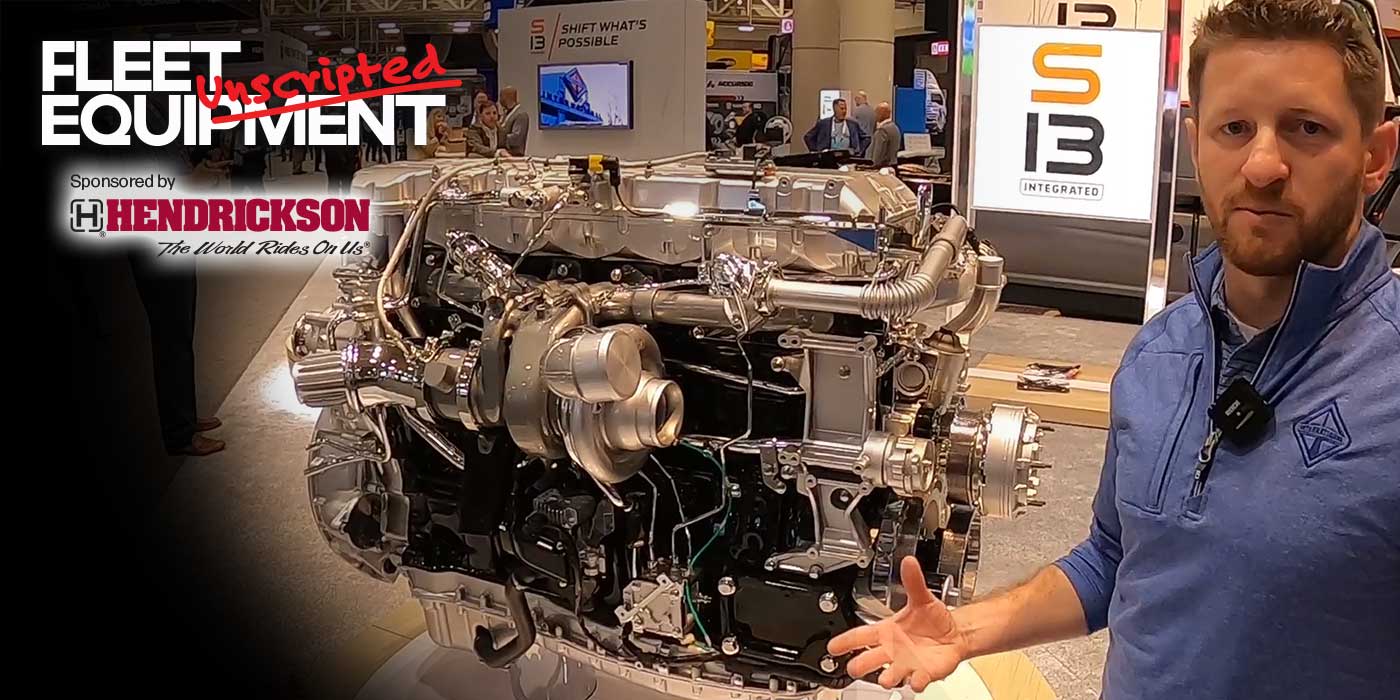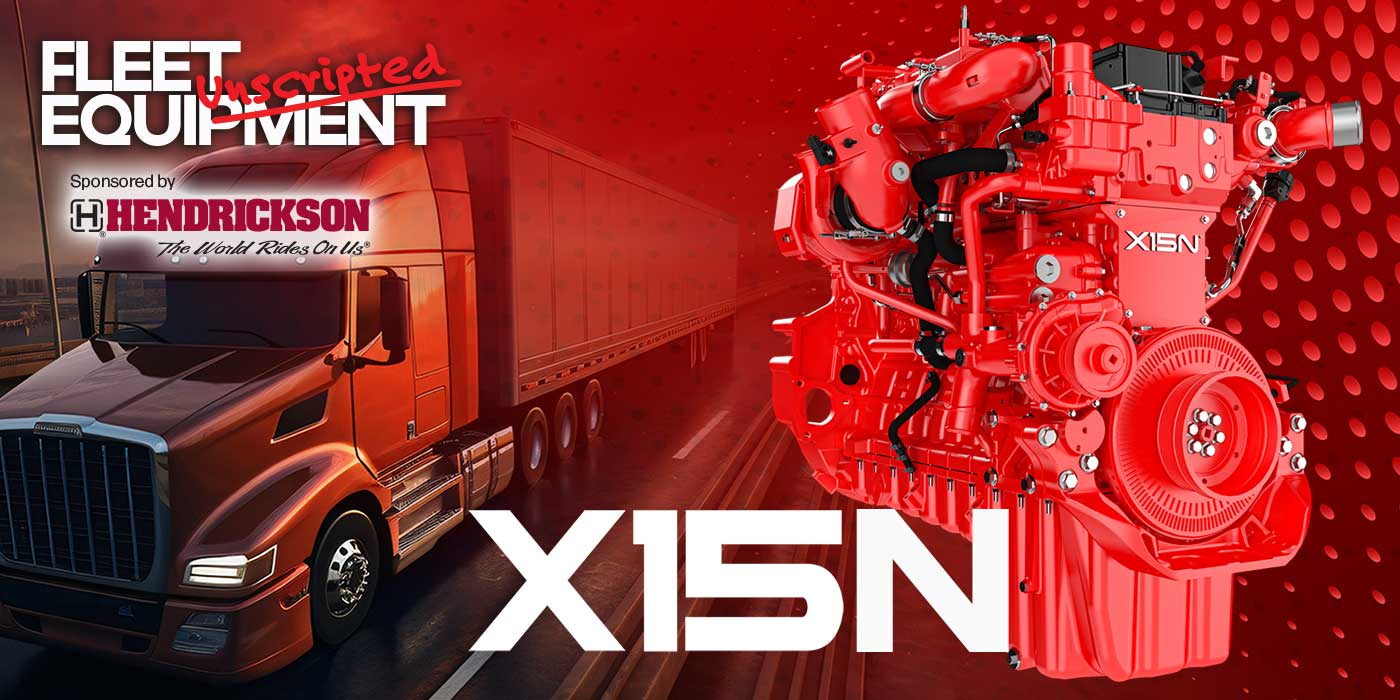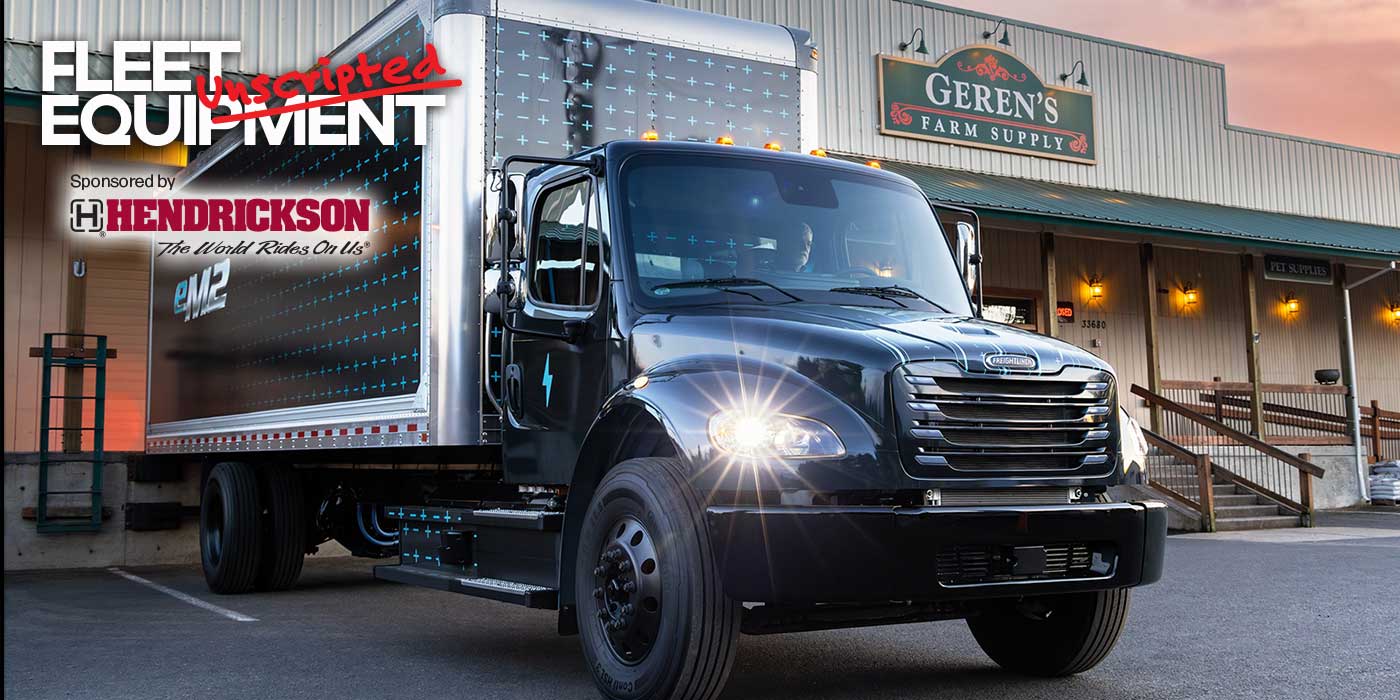The headline can seem like a silly question, but consider the Hyliion Hypertruck ERX–it’s an electric powertrain truck where batteries are being charged and they power the Meritor 14Xe e-axle. But it has a range of 1,000 miles. The catch? The batteries are charged by an on-board natural gas generator and the truck is fueled up with compressed natural gas. From a driver point of view, the experience is much more comparable to a battery electric truck vs. a diesel or even natural gas truck because of the electric powertrain. From a fleet point of view, it’s a hybrid with an ICE natural gas engine, so how much more sustainable is your operation?
And this is where the sustainability conversation becomes complicated. Sustainability means more than eliminating tail pipe emissions. Let’s say you do that but you charge your trucks via a utility that is burning coal to supply you. You just moved your emissions load from your trucks, to the utility.
Thomas Healy, founder and CEO of Hyliion, answers the natural gas emissions question with: If you’re using renewable natural gas, you could actually have a net-negative carbon score operating the Hypertruck ERX (“net-negative” is a good thing.) During a ride in the Hypertruck ERX across Austin, Texas, highways, I talked with Healy about electric powertrain development, the role of hybrids in sustainable equipment strategies, and where he sees the Hypertruck ERX fitting into the market.
Watch the video above for the Hypertruck ERX ride and drive and conversation with Healy.

No script? No plan? No problem. Welcome to Fleet Equipment Unscripted—the video interview series that connects you with the greatest minds in the heavy-duty trucking world.
Bookmark the Fleet Equipment Unscripted page to catch all of our Unscripted episodes, and subscribe to our newsletter by clicking here to have the latest news and in-depth trucking stories delivered straight to your inbox.
Fleet Equipment Unscripted is sponsored by Hendrickson.
Here’s the transcript
Jason Morgan:
Hi, everyone. Jason Morgan, content director for Fleet Equipment. Welcome to Fleet Equipment Unscripted. I’m at Hyliion. We’re going to take a drive in the Hypertruck ERX. We’re going to talk with Thomas Healy to get a update on where the company is, where the products are, and how this is all fitting into decarbonization, sustainability, and electric powertrain offerings for a fleet. Come along, and let’s see what we can learn.
Jason Morgan:
Because we’re in the Hypertruck, which is…
Thomas Healy:
Full electric, electric extender.
Jason Morgan:
… full electric, fueled with compressed natural gasses, so a hybrid in-theory, because you’re fueling with natural gas. Yeah, it’s getting put into a generator and producing electric power train, but you were referring… You still offer a diesel hybrid, where you can put the electric axle on a diesel. Right?
Thomas Healy:
That is correct. We’ve got two different product lines: the Hybrid and the Hypertruck ERX. Hybrid, it’s a very large Toyota Prius, is the best way to think about it. Your primary drive’s still coming from the ICE, but you can use that electric axle to apply torque and [inaudible 00:01:12] braking. Then, we have the Hypertruck ERX, which is what we’re in right now. Full electric drive. Right now, you’re just running on the battery pack, and then it’s got an onboard generator that can kick on and charge the batteries as you’re going. And actually, about 30 seconds ago, the generator actually did kick on, and what’s happening now is the generator’s going through a warmup cycle, and now it’s actually starting to kick on, start producing horsepower, and start charging the batteries up.
Jason Morgan:
And just for product clarification, the diesel hybrid product, I can put that on any truck. That’s a retrofit, so any truck that I have, I can turn it into a hybrid today.
Thomas Healy:
Right.
Jason Morgan:
And then, the Hypertruck we’re sitting in, this is a deal with Peterbilt. Right? I go through you, or I go through Peterbilt, and then, how does that manufacturing process work?
Thomas Healy:
It’s going through us today. Our long-term play is, you look at this… Long vision is, we want to be an on-the-line option, hopefully [inaudible 00:02:14] by from any OEM. to launch this product, though, we decided to team up with Peterbilt, launch it on the Peterbilt 579 chassis, and this will be all the initial vehicles that we deploy, deliver, but we’ll evolve that business model as we go forward.
Jason Morgan:
For sure.
Thomas Healy:
Right now, we’re working with the fleets, as opposed to the OEM working with the fleets.
Jason Morgan:
Right. Okay. Because, so I put the order through to you, and we’re in Austin, which isn’t too far from Denton, where Peterbilt’s manufacturing. It rolls off the line down there, comes to you all, you all fix it up into the Hypertruck configuration, and then I pick it up here. Right?
Thomas Healy:
That’s how it’ll launch. Right now, where we’re at in the development process is, the vehicle we’re in is a development unit. But later this year, we’re going to start controlled fleet trials, which will actually be deployments in fleet operations of these trucks. That’ll carry into ’23. In ’23, the things we need to check the box on are CARB certification, EPA certification, as well as [inaudible 00:03:10]. We’ll get those done, and then that’ll put us on track. In the latter part of ’23, we’ll go into production with this vehicle.
Jason Morgan:
Okay. Very cool. The noise we hear right now is the generator working. Still not as loud as a diesel. We’re still having a normal conversation, so still not as loud as that, but the truck is charging. Right?
Thomas Healy:
Correct. Yeah. Not the reality, but an analogy is, we basically got the extension cord with us, and we’re driving around.
Jason Morgan:
Right. Right. No. And Hyliion has been ahead of the game in a lot of this. You had your diesel hybrid option out before anyone… I think really close before anyone announced an electric truck. Right? And now, that conversation in the industry has gained a lot of ground, so the idea of wrapping your head around, “Okay, you don’t have to necessarily worry about the infrastructure conversation charging the battery.” Natural gas is a… That’s the other challenge. It has a foothold. People run natural gas. I see natural gas fueling stations, but bringing that a little bit more to the market, or knowing where to get your fuel, would be the challenge in running the truck.
Thomas Healy:
Yeah. And so, we’ve had a lot of fleets in, and we’re doing ride and drives. The number one issue we’re hearing from fleets about adopting BEV electric trucks is the infrastructure. They’re getting a little over a hundred miles of range out of the current trucks that are on the market, and they’re finding that suits a very small part of their fleet that can actually do that. And then, what they’re seeing is, “If I go to a much larger battery pack, I now need higher rate chargers,” which has substantial incremental cost, as well as they’re even finding that the grid can’t even support that much charging. There’s not enough capacity.
Thomas Healy:
We heard from a fleet who specked out a new warehouse, that went to their utility provider. They said, “How much electricity’s available? Good. We can do electric trucks. That’s great.” Built the warehouse. They went back to say, “All right, I’m ready to claim the electricity.” Others had already taken it, and now, they couldn’t [inaudible 00:05:11] electric chargers into their new warehouse. The excess capacity available on the grid is pretty limited, and that’s where natural gas, over 700 stations are already out there, usually very easy to get to, right out the highway-type stations. And you can pull the truck in 10 to 15 minutes, do a full refuel with the natural gas, and then you’re back out on the road.
Jason Morgan:
Right. You touched on application a little bit here, because battery electric’s still very niche, long haul is still a question, and we’re in a 579 Peterbilt, which is their flagship long haul truck. How do you talk about range in this truck, or… I don’t know… miles-per-whatever you’re fueling in the natural gas. How do you work that?
Thomas Healy:
Range of this vehicle is over 1,000 miles per refuel. And so, it’s basically like a diesel truck in terms of range. Now, the solution we’re bringing to market first; it has a 75-mile EV range to it before the generator needs to kick on, or before you need to start using natural gas. The neat thing with that is, since it’s 75 miles of EV range, we actually can qualify for ZEV credits. Both the credits that the OEMs are going to need, as well as the proposed credits that the fleets are going to start having mandated on them as well.
Jason Morgan:
Okay. And so, it’s been a while since I’ve talked about natural gas, so excuse me, but what are the emissions like on natural gas? You can run, in a city center, 75 miles on purely the battery power on this truck. What are the emissions like from the natural gas when the generator’s on?
Thomas Healy:
Yeah. When the generator’s off, you’ve got zero tailpipe emissions. An EV truck. Right? When the generator’s on, you do have tailpipe emissions that are coming out, but when you actually look at well-to-wheel, and the fact that a lot of fleets are using renewable natural gas as opposed to just conventional natural gas, you can actually drive a below-zero or net carbon-negative emissions profile in the truck. RNG, renewable natural gas, is basically process of capturing methane coming off of landfills, dairy farms, wastewater treatment plants, pump that into the pipelines, and use that as your fuel in the truck. It’s taking what was going to be pollution and use that to actually drive a vehicle, or charge a battery pack. And when you do that, you have the potential to get below-zero emissions profiles. And then, the next question people usually say is, “What, is renewable natural gas 1% or 2% of the market?” And the crazy stat is actually, last year, we surpassed that. Over 50% of the fuel sold stations already came from renewable natural gas.
Jason Morgan:
Okay. Okay. Right. Because any emissions I’m putting out at the tailpipe is less than the emissions that already existed, that they were pulling the energy from.
Thomas Healy:
Exactly.
Jason Morgan:
Okay. All right. Very cool.
Thomas Healy:
And another interesting stat on that one is, even California found last year, even just using fracked natural gas is actually has a lower carbon intensity score, a CI score, than grid electricity in California. Even if you didn’t have access to renewable natural gas, it’s actually cleaner than the grid electricity.
Jason Morgan:
Right. Right. That is just so variable across your location, what utilities are available. Even thinking about it from a consumer side, in Ohio, I can select where I want my energy to come from. Not everyone has that choice, and you’re just beholden to wherever you’re getting that. And so, it’s one of those things where you try to do your part, but how do you control that… to your point, the well-to-wheel? Right? How can you mitigate that as much as possible?
Thomas Healy:
And then, it will also come down to cost. Right? If you go to your utility provider and you say, “I want all this to come from wind and solar,” they’re going to charge you more for that. Right? The nice thing with renewable natural gas is that we’re finding fleets can go buy a gallon of natural gas at station, if they have a contract with the station, for about a dollar a gallon.
Thomas Healy:
Two months ago, when we were having this conversation, I would’ve said, “Diesel price is $3, $3.50.” Today, who knows where they actually are? $5.
Jason Morgan:
Holy moly.
Speaker 4:
$7 in California.
Thomas Healy:
Is that what they’re up to now?
Speaker 4:
Getting close to.
Thomas Healy:
Wow. But natural gas has stayed pretty steady in terms of pricing at the station. And the reason for that is that a lot of the cost with actually buying natural gas to fuel up your truck is actually in compressing the gas, is where a lot of the cost is. The actual commodity of natural gas is not a big percentage of that dollar that you spend. Even if natural gas prices fluctuate, we don’t see as big of a fluctuation on the actual cost of fueling up the truck.
Jason Morgan:
Right. Tell me about the eAxle technology. What are you using here, and what are some of the cool innards of it?
Thomas Healy:
Yeah. We’ve got the Meritor 14Xe eAxles on this truck, dual axles. They are two-speed. I don’t know if you had noticed, but around 25, 30 miles an hour, the axles that actually shift… Now, one of the things that we’ve done… Which we think is pretty unique… is, we actually independently shift the axles. While one is shifting, the other’s still applying torque. And then, when the other one’s shifting, the other axle’s applying torque. You never fully lose the acceleration of the vehicle. Unlike a diesel truck, when you go to shift from six to seventh gear, you lose all your power, the cab rocks back down… That’s why you get this shaking motion in the cab in a diesel, versus in here, you don’t get any of that, because the electric axles are shifting independently.
Jason Morgan:
Okay. Did you say that’s something that you’re doing and controlling on the power management side?
Thomas Healy:
That’s correct. Yeah.
Jason Morgan:
Okay. That’s interesting, because the conversations about… The Meritor axle, it’s popular in the industry. You’re seeing it on a lot of name plates, but understanding the role of integration in the EV world is interesting, how much you can tweak and impact the operation. You have a good amount of control over that, then?
Thomas Healy:
We do. And with that, though, it’s absolutely done in a collaboration with Meritor, who now is going to be [inaudible 00:11:11] here. We worked closely with their engineering team to see what parameters they had set on the axles, and then we work within those, but do our best to make sure that you’ve got that smooth acceleration. All the controls of, when you step on that pedal, how much torque, that’s all being developed by Hyliion. We’re just working within the bounds of what the eAxles can do.
Jason Morgan:
Right, right. And you still have a partnership, or relationship, with Dana, and that axle’s in use. Is that more on the diesel hybrid product side?
Thomas Healy:
Correct. The hybrid, both on a diesel truck and/or on a CNG truck as well, we’re using the Dana axle motor attached to it in order to assist that vehicle with power.
Jason Morgan:
Okay. Just for clarification on my side, the Dana hybrid CNG, that’s on an existing CNG truck that you’re retrofitting?
Thomas Healy:
Correct. And the push from the industry has been many CNG trucks’ drivers feel as though they’re underpowered, they don’t perform like a diesel truck. Obviously, this isn’t that way, because this is electric drive. Right? But the hybrid, what we’ve found is, customers want us to put that hybrid system on that eAxle that has 120 horsepower as a way to make a conventional CNG truck perform a little bit more like a diesel does.
Jason Morgan:
Right. Right. And I know the diesel hybrid product has been… You’ve been showing it off for quite a while. Remind me on some of the fuel efficiency benefits of this. What is the real ROI on that?
Thomas Healy:
Yeah. It depends on where you’re running the vehicles. Right? If you’re in very hilly terrain areas, that’s where you’re going to see the best savings, because we can capture that wasted energy. And then, the other aspect is, you’re going to use that as an APU. When the driver’s sleeping in the cab, they can actually turn the engine off, run all the air conditioning off of our high-voltage cooling system to produce AC. Now, when you go to install it on a CNG truck, though, it’s not about fuel economy performance, it’s about giving that driver that extra horsepower, that extra torque.
Jason Morgan:
For sure.
Thomas Healy:
And, when you were in the shop, you actually saw both hybrid systems being installed. There were some diesel trucks, and there were some CNG… [inaudible 00:13:15]
Thomas Healy:
Think we’re going to have you drive, now.
Thomas Healy:
Very similar to your diesel truck. Release the air brakes here. And then, to shift our system into drive, you just hit the D there.
Jason Morgan:
Okay. Good?
Thomas Healy:
Ready to go.
Jason Morgan:
Now, I did mention I grew up driving a Camaro, and we just hit the launch of this one.
Thomas Healy:
Feel free. Thing is a lot of fun under acceleration.
Jason Morgan:
Is the compressor still going? Is it charging now?
Thomas Healy:
The air compressor is running. Now, the reason for that is because, when you release the air brakes, it depletes the tank some, so now we’re charge it up. That’s the air compressor turning off, and you’re in full electric drive mode right now.
Jason Morgan:
Okay. And you mentioned earlier I can control the regenerative brake and power up here. Right?
Thomas Healy:
That’s correct.
Jason Morgan:
You just touch it and it changes it. Right?
Thomas Healy:
Yeah. If you go in a high with bobtailing, if you let off and it goes full regen, it’ll chirp. Now, you’re welcome to do that.
Jason Morgan:
I don’t want to.
Thomas Healy:
It doesn’t damage the vehicle at all, it just…
Jason Morgan:
Yeah, your tire costs go up.
Thomas Healy:
Yeah. But then, if you hit it into low, you’ll see it’s just less regen.
Jason Morgan:
I’ll do that. All right. Low test. Okay.
Thomas Healy:
Still a little bit of drag, but not as much as higher levels.
Jason Morgan:
For sure. And one of the things I noticed, too, is that… Let’s see how this goes… the regenerative braking, sometimes… And that one comes down really pretty good, really pretty quick.
Thomas Healy:
Yeah. You’re medium now. Yeah.
Jason Morgan:
Will it go to full stop, or will it just crawl…
Thomas Healy:
The last couple of miles an hour, you will need to hit the physical brakes.
Jason Morgan:
Okay. That seems to be pretty standard across a lot of regen braking, because you want to keep generating as much as possible. [inaudible 00:15:04].
Thomas Healy:
Really just to hold it. You can glide to a stop, but it’s really holding the vehicle.
Jason Morgan:
Yeah. When I’ve done some of these test drives, even on the more medium-duty ones…
Thomas Healy:
Feel free to keep looping if you want.
Jason Morgan:
Yeah. I’ll do another one. I would stop a car’s length before I really wanted to, getting used to that.
Thomas Healy:
And that’s one of those integration points. Right? How you tune the pedal, there’s a lot of skill in that, and how smooth it is, how easy to control the vehicle.
Jason Morgan:
There it goes. It goes. It’s been amazing to watch that evolution. You look at something like a diesel with an AMT… Right? … which are really pretty good, and you don’t feel a lot of the load, and it takes a lot of that strain off, but this is just another level. You’re driving full EV.
Thomas Healy:
And you should do another lap and come to a dead stop at the end back there and just floor it, just so you can see the full vehicle performance.
Jason Morgan:
All right. You really… Yeah. There is documentation that I was instructed to do this, so I’m sure… I know I signed something coming here, but I wonder if this releases me from liability. No, this is really, really cool. And you said a thousand miles in range on a CNG fill?
Thomas Healy:
Correct.
Jason Morgan:
That’s pretty excellent.
Thomas Healy:
Now, you’re basically taking what is an electric truck and moving it into having the performance characteristics, from a range standpoint, of a diesel. And what we found is, many fleets… If you’re driving 500 miles a day, you’re going to pass a few stations along your route. Right? With that network of 700 stations. Obviously, takes a little more planning than a diesel truck does. Right? Diesel, you can stop almost anywhere, but comparing it to the electric infrastructure out there for charging semi-trucks, it’s far, far superior.
Jason Morgan:
Right. Or even, in this application. We’re talking long haul in a lot of… 579, there is no infrastructure.
Thomas Healy:
Right. It doesn’t exist.
Jason Morgan:
The hydrogen isn’t a thing, and battery electric isn’t… The industry has figured out, as to your point earlier, it’s not ready for battery electric. Right?
Thomas Healy:
Right.
Jason Morgan:
It might be 15 years away, 20 years away before batteries are even… They say battery technology moves quickly.
Thomas Healy:
But honestly, the battery technology will surpass the infrastructure capabilities. We’ll have batteries that can drive you 500 miles, we’ll have batteries that weigh less, but the problem is, there’s not going to be a grid able to charge them.
Jason Morgan:
Right. And then, how far out do you see… You got a 75-mile pure electric range right now. Give me another 40 miles and you’re up into where a full-battery electric truck is running right now. How far off do you see that? How far have batteries come already since you’ve been doing this?
Thomas Healy:
What we’ve actually found is, batteries are not our weak point in the equation anymore. Right? For a BEV plug-in truck, batteries are absolutely the weak point today, and infrastructure is the weak point as well today, but I think it’s going to be the main weak point in the future, or pain point in the future. With this, the batteries we have today are plenty good. We don’t need evolution in them anymore. What we’re actually working on is, how do we keep on evolving the generator to be more efficient in producing the electricity? Because if we can keep on making that more and more efficient, that will increase your range on the same size of tanks.
Jason Morgan:
Okay. Okay. I see. Where are you sourcing your generator from? Where do you get that from, and is it comparable to… For example, Cummins announced a fuel-agnostic engine platform. Would that be something that fleets could put in here on a CNG engine, or is this a completely different beast?
Thomas Healy:
This truck is a ICE engine within a electric motor hooked to the rear. We have not announced the maker of the engine, but it’s a natural gas engine. That’s this truck. It’s basically a conventional engine, more or less, that runs on natural gas. What we’ve put on our roadmap, though, is, while we’re using an ICE engine today, we’re going to move to a fuel-agnostic, and then to a fuel cell. Now, our fuel agnostic is not a ICE fuel-agnostic, like some of the other announcements out there.
Thomas Healy:
It’s actually a non-internal combustion engine that can run on various fuel types. And so, when you do that, it really is another leap forward, because now you can offer to a fleet, “This same truck could run on nat gas, or it could run on hydrogen, and it really gives fleets flexibility. Then, we see the long-term solution being fuel cells, but in order to get to there, you do need that infrastructure built out. We see fuel cells as, it will start in local deployments, regional-type applications. And then, whenever hydrogen stations do get built out, then it could be an application for over the road.
Jason Morgan:
Okay. Then, do you really see yourselves as an integrator, or powertrain management company? You know what I mean?
Thomas Healy:
Yeah.
Jason Morgan:
The evolution of Hyliion, if it’s not what’s driving… Because like you said, you can swap out that power plant, so to speak. How do you define yourselves in that kind of new future?
Thomas Healy:
Yeah. I think our roadmap evolves, or what we are as a company evolves. Today, all the software integration on this vehicle is done by Hyliion. The battery technology… You saw our battery room. We also make our own battery modules, so that’s a core part of what we do. We see that we’ll expand to more aspects of the vehicle as well, or of the powertrain, I should say. For instance, the generator. That fuel-agnostic generator, that is something that Hyliion is working on. And so, we see that as a way that we can take over another component of the vehicle.





